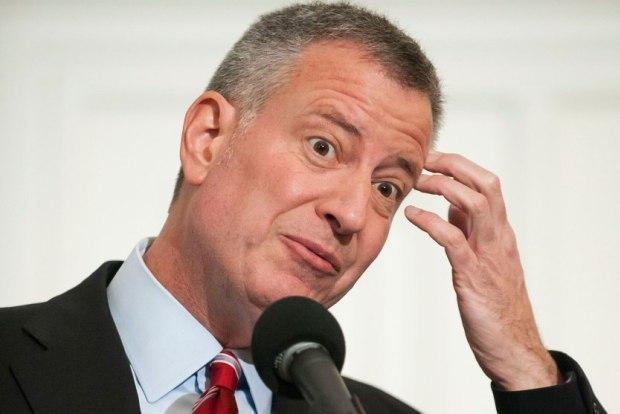New York City’s annual homicide total has surpassed 300 for the first time since 2016, fueled by pockets of gang violence, a pair of quadruple killings and an unusual number of bookkeeping adjustments.
Through Dec. 22, the city has tallied 311 homicides, compared with 290 at the same point last year.
It’s the second straight year of increases after the city achieved a modern-era low of 292 homicides in 2017, but this year’s total is skewed in part by an outsized number of deaths carried over from years past.
At least 27 deaths in this year’s statistics happened prior to 2019 but weren’t classified as homicides by the city’s medical examiner until this year, the police department said. They must be counted in the statistics for the year the death certificate is issued.
There were half as many reclassifications counted in last year’s statistics.
Through the end of November, the city tallied 272 homicides involving people killed this year, Deputy Chief Lori Pollock said. At the same time last year, there were 275.
“We don’t like to talk about it because it’s fairly consistent through the years, but this one happens to be — it hasn’t happened since 2006 where you had this many classifications over the year before,” Pollock said.
New York finished last year with 295 homicides, down from 335 in 2016. The recent tallies are a far cry from the early 1990s, when the city averaged about 2,000 killings a year.
New York, the nation’s largest city, with about 8.6 million residents, has a homicide rate of about 3.6 per 100,000. That makes it statistically far less deadly than some other big cities.
Philadelphia, which has about 1.6 million residents, had 351 homicides as of Friday, for a rate of about 22 per 100,000. Chicago, which has about 2.7 million residents, has had 482 killings this year, for a rate of about 17.8 per 100,000.
Fluctuations in crime statistics are expected, criminologist David Kennedy said, and this year’s increase in New York’s homicide total shouldn’t be seen as evidence of a trend.
“Most of that change itself can be accounted for by a couple of standout incidents,” said Kennedy, a professor of criminal justice at John Jay College. “This is well within the absolutely expected fluctuation of what happens with violent crime rates.”
Halfway into this year, New York was on pace for its lowest annual homicide total since 1951, but a spate of killings in the second half of the year sent the tally higher.
In October, a homeless man allegedly beat four men to death with a metal pipe as they slept on the Manhattan streets. Days later, four people were killed at a Brooklyn gambling den.
The city’s increased homicide total can be traced to spikes in just a few neighborhoods.
In the Crown Heights precinct, where the gambling den was located, there have been 14 killings this year after just two at the same point last year.
There were at least six other fatal shootings and several deadly assaults, including that of a 74-year-old man found beaten at a nursing home.
In Queens, a precinct covering parts of Jamaica, St. Albans and Hollis has seen a threefold increase in homicides over last year, going from five to 15.
The victims include three people killed in a Nov. 21 arson fire and a 3-year-old girl killed in May when her father allegedly torched their car.
The Brooklyn precinct covering Coney Island and Brighton Beach has had six killings this year after posting none last year. A precinct in the Bronx neighborhood east of Yankee Stadium has seen its year-over-year total double, from six to 12.
“We continue to see a high percentage committed by gangs and gang involvement,” police commissioner Dermot Shea said at a crime briefing this month.
In recent years, the police department has been aggressive in seizing illegal guns and increasing patrols in problem areas.
It has also transformed how officers interact with residents, implementing a strategy that pushes officers out of their patrol cars and onto streets to build bonds in the communities they police.
Across the city, other crime categories, such as shootings, robberies and felony assaults, have trended slightly higher this year.
One unanswered question is what effect, if any, approaching changes to the bail system will have on crime statistics and homicide totals. Changes taking effect Jan. 1 include eliminating bail for nonviolent felonies.
Unions representing the city’s police officers have voiced fears that the reforms will increase crime and allow criminals to roam the streets, but Kennedy isn’t so sure.
“Almost everybody who is held (in jail) is not dangerous, and almost everybody who is held, if they were not held, would not hurt somebody if they were on the outside,” Kennedy said. “So, it’s extremely unlikely that homicide and violent crime are going to shoot up.”
(AP)












6 Responses
The askonim who endorsed him should apologize, at the siyum hashas. I didn’t vote for this.
Very much in tune! Really in touch!
Fake statistics!
NYC liberals CANNOT BE TRUSTED
Out with deblassio. He is destroying New York.
300 this year???
Aren’t they ashamed!!!
It’s a fact they are not recording most crimes…. When someone calls NYPD they discourage him to make a report!
Who knows if the real number was in the thousands!
It’s a shame that NYC the capital of America has such a פערד for a mayer…
Whatever, our talks over here won’t bring anything…
He most probably tweeted already that he has his secret task force on the case, and soon will Cuomo tweet as well that his private state Tropper investigaters are on the case…. (case of only giving ticked here in NYC, that’s the only thing they are doing here!)
Look into CompStat for why NY police are incentivized to underreport or misclassify crime.